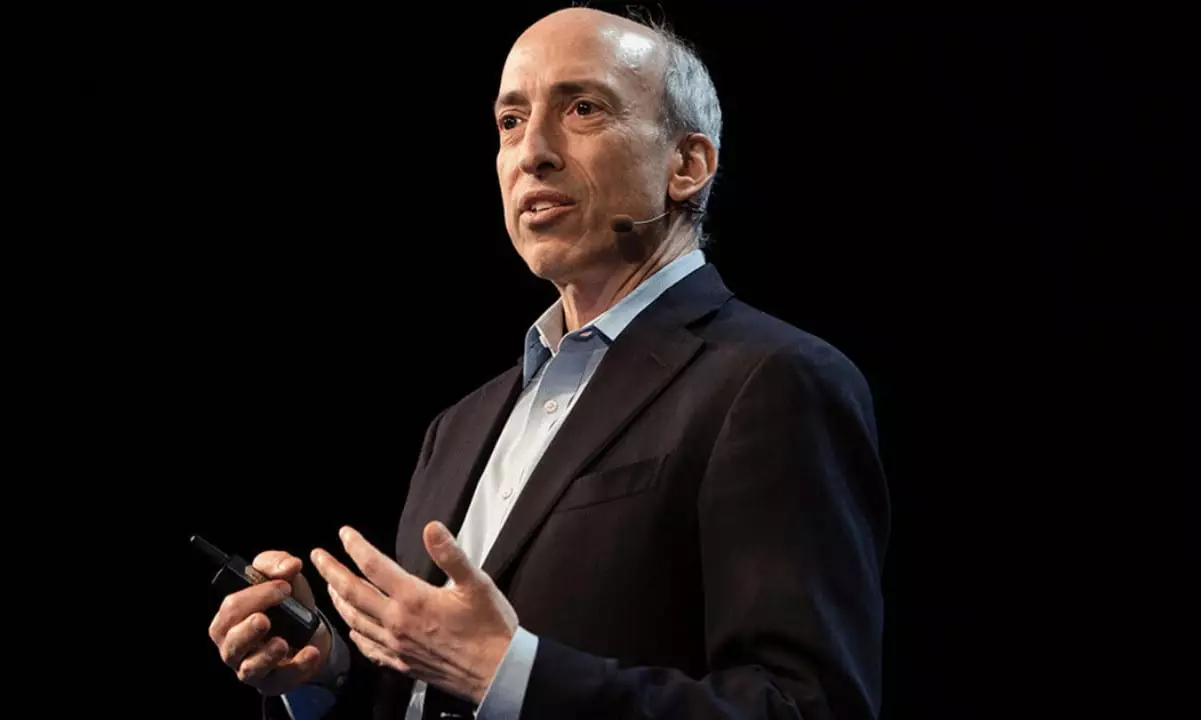Gary Gensler’s voice resonates through the cryptocurrency arena like a dissonant chord, pointing to a worrying truth that many enthusiasts might prefer to ignore: the overwhelming influence of market sentiment on digital assets. In a recent stark interview on CNBC’s Squawk Box, Gensler argued that the valuation of cryptocurrencies is largely disconnected from the intrinsic fundamentals one would typically expect in traditional financial markets. This assessment suggests that the so-called “cryptocurrency revolution” is more akin to a speculative frenzy, driven by social media trends and tweets rather than any concrete financial metrics.
It is shocking to consider that Gensler estimates that a staggering percentage, if not nearly all, of crypto value is essentially speculative, echoing the sentiments of fervent social media users rather than investors analyzing balance sheets or cash flows. Such a landscape creates an untenable situation; assets could surge or plunge based solely on the whims of public opinion, rather than on any tangible business performance or future potential.
The Vulnerability of Altcoins
In the chaotic theater of crypto trading, altcoins are a particularly fragile cast. Gensler’s assertion highlights that many of these assets are designed largely for hype rather than utility. With thousands of altcoins saturating the market, it is hard to imagine a scenario where all, or even most, hold lasting value or relevance. This bubble of sentiment-driven currencies is ripe for burst; investors might one day realize that these tokens lack substantive backing and are merely symbols of fleeting interest.
Gensler’s warnings about the performance of these tokens are profound. The reality is that once the thrill of novelty wears off, these currencies could face dramatic declines, reflecting a market realization of their dubious value. The crypto landscape may soon look much like a graveyard of failed projects, with countless investors left in the lurch, facing dire financial repercussions due to ill-fated gambles on sentiment.
Bitcoin as a Digital Gold
Nevertheless, amidst this sea of volatility, Gensler acknowledges Bitcoin’s potential to persist, setting it apart from a universe of hopers and dreamers. He draws a parallel between Bitcoin and gold, suggesting that just as gold serves as a storied hedge and beacon of intrinsic value, Bitcoin may carve out its own space in the financial lexicon. What is clear is that Bitcoin’s durability stems from genuine global interest, as it has transcended mere digital asset status to becoming a kind of financial phenomenon.
With approximately 7 billion individuals globally, Bitcoin garners their attention in a way that most altcoins cannot. Gensler’s assessment presents a dual narrative: hope for Bitcoin’s enduring relevance while casting doubt upon the sustainability of the majority of its peers. This philosophical distinction underscores a significant point about trust in financial assets: it is not enough for something to exist; it needs to be respected and sought after.
Macro-Economic Influences Affecting Crypto
Interestingly, Gensler’s discussion doesn’t confine itself exclusively to cryptocurrency. He brings a broader lens on economic dynamics, particularly between the U.S. and China. The intricate dance of tariffs has introduced volatility that trickles down to digital assets, reflecting how broader financial landscapes impact crypto markets. His warning about a potential “quagmire” stemming from inconsistent policies is particularly salient; the world increasingly lives in an interconnected climate where decisions ripple across the globe.
These financial uncertainties have already shown their effects, with digital asset investment products experiencing significant outflows — nearly $800 million recently. Such numbers expose the fragile relationship between cryptocurrency markets and traditional economic indicators. When the mainstream markets wobble, even the more stable digital currencies feel the pressure, diminishing the aura of crypto as a hedge against traditional economic instability.
The Future: AI and Crypto Trading
As Gensler transitions into academia, exploring the intersection of Artificial Intelligence (AI) and finance, he hints at transformative possibilities. AI’s capacity to reshape trading paradigms cannot be overstated, nurturing an era where machines assist in making sense of the chaotic narratives that drive market sentiment. Yet, he notes that despite these advances, we are not yet at the threshold of high-frequency trading with AI—a sobering reminder that even innovation has its limitations.
As our finance world becomes increasingly algorithm-dependent, one must consider the implications of this shift. Could the reliance on AI give rise to new forms of market manipulation, shrouded under the guise of “advanced trading strategies”? As we marvel at the technological revolution, are we fully aware of the ethical complexities we are stepping into—or could these smart algorithms be the very culprits fueling the next great market disaster that Gensler seems to fear?

